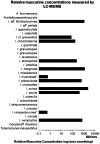Evolution of the toxins muscarine and psilocybin in a family of mushroom-forming fungi
- PMID: 23717644
- PMCID: PMC3662758
- DOI: 10.1371/journal.pone.0064646
Evolution of the toxins muscarine and psilocybin in a family of mushroom-forming fungi
Abstract
Mushroom-forming fungi produce a wide array of toxic alkaloids. However, evolutionary analyses aimed at exploring the evolution of muscarine, a toxin that stimulates the parasympathetic nervous system, and psilocybin, a hallucinogen, have never been performed. The known taxonomic distribution of muscarine within the Inocybaceae is limited, based only on assays of species from temperate regions of the northern hemisphere. Here, we present a review of muscarine and psilocybin assays performed on species of Inocybaceae during the last fifty years. To supplement these results, we used liquid chromatography-tandem mass spectrometry (LC-MS/MS) to determine whether muscarine was present in 30 new samples of Inocybaceae, the majority of which have not been previously assayed or that originated from either the tropics or temperate regions of the southern hemisphere. Our main objective is to test the hypothesis that the presence of muscarine is a shared ancestral feature of the Inocybaceae. In addition, we also test whether species of Inocyabceae that produce psilocybin are monophyletic. Our findings suggest otherwise. Muscarine has evolved independently on several occasions, together with several losses. We also detect at least two independent transitions of muscarine-free lineages to psilocybin-producing states. Although not ancestral for the family as a whole, muscarine is a shared derived trait for an inclusive clade containing three of the seven major lineages of Inocybaceae (the Inocybe, Nothocybe, and Pseudosperma clades), the common ancestor of which may have evolved ca. 60 million years ago. Thus, muscarine represents a conserved trait followed by several recent losses. Transitions to psilocybin from muscarine-producing ancestors occurred more recently between 10-20 million years ago after muscarine loss in two separate lineages. Statistical analyses firmly reject a single origin of muscarine-producing taxa.
Conflict of interest statement
Figures


References
-
- Young A (1994) Muscarine-containing mushrooms. Spoerke DG, Rumack, BH (Eds), Handbook of mushroom poisoning: diagnosis and treatment: 289–299.
-
- Benjamin DR (1995) Mushrooms: poisons and panaceas. New York: WH Freeman and Co.
-
- Besl H, Mack P (1985) Halluzinogene Rißpilze. Z Mykol 51: 183–184.
-
- Bresinsky A, Besl H (1990) A colour atlas of poisonous fungi: A handbook for pharmacists, doctors, and biologists. London: Wolfe Publishing Ltd.
-
- Brown J, Malone M, Stuntz D, Tyler Jr V (1962) Paper chromatographic determination of muscarine in Inocybe species. J Pharm Sci 51: 853–856. - PubMed
Publication types
MeSH terms
Substances
LinkOut - more resources
Full Text Sources
Other Literature Sources

